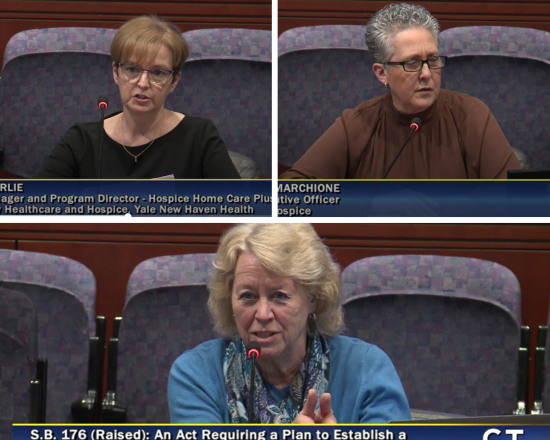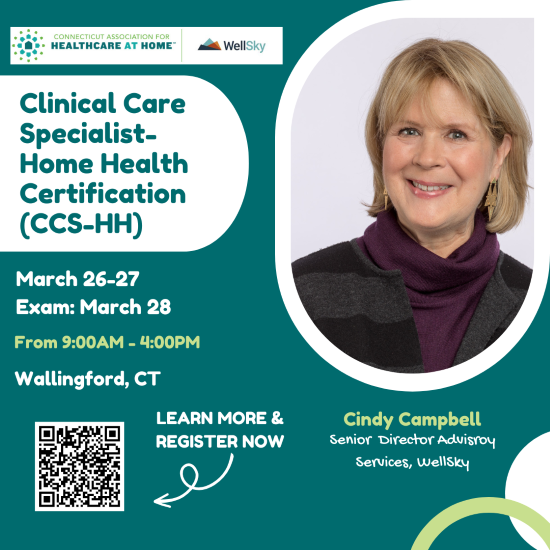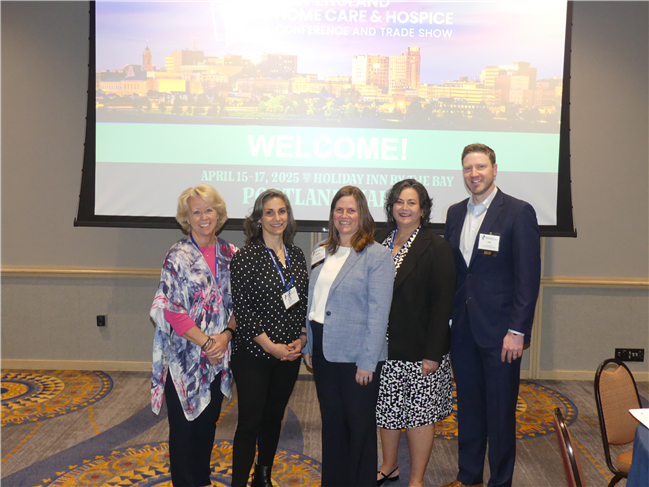 |
|||||||||||||||||||||||||||
| February 29, 2024 | |||||||||||||||||||||||||||
Source: CT Hospital Association
This week, Connecticut Senate Democrats held a series of press conferences. On Wednesday, Feb. 21 the caucus focused on healthcare priorities for the session. Caucus leaders, including Senate President Pro Tempore Martin M. Looney (D-New Haven) and Senate Majority Leader Bob Duff (D-Norwalk), highlighted proposals to address the safety of home care workers, increase prescription drug affordability, and expand the state’s paid sick leave program.
The Public Health Committee held a public hearing Monday, Feb. 26 to address three raised bills impacting the Association members and their home care industry.
HB 5197: AN ACT CONCERNING SOCIAL WORKERS
HB 5198: AN ACT CONCERNING TELEHEALTH
Several of our hospice providers either submitted written testimony or testified in person. To view testimony, click on the links below:
Source: NAHC, Feb. 26, 2024
The February 2024 quarterly refresh for the Hospice Quality Reporting Program is now available on Care Compare. For additional information, please see the FY2024 Hospice Wage Index Final Rule.
Please visit the Hospice Background and Announcements webpage to review the Claims-Based Measures Questions and Answers downloadable (PDF) for more information on the Hospice Care Index (HCI) and Hospice visits in the Last Days of Life (HVLDL).
Source: NAHC, Feb. 27, 2024
Home Health Care Consumer Assessment of Healthcare Providers and Systems (HHCAHPS)
The agenda and slides for the self-paced 2024 Introduction to the HHCAHPS Survey training and the HHCAHPS Survey Vendor Update training are now posted under the “Training” tab of the HHCAHPS website.
CMS reminded participants that it is the HHA’s responsibility to ensure that their vendor is submitting the HHCAPHS data in a timely manner.
CMS also reminded home health agencies (HHAs) seeking an exemption from participating in the HHCAHPS Survey for the calendar year (CY) 2025 annual payment update (APU) period to submit a Participation Exemption Request (PER) form on the HHCAHPS website. The deadline for submitting the CY 2025 APU exemption request is 11:59 p.m. ET on March 31, 2024.
Expanded Home Health Value Based Purchasing (HHVBP) Program
CMS announced a new email address for the HHVBP help desk HHVBPquestions@cms.hhs.gov
CMS also reminded participants that the January 2024 interim performance reports are available in the Internet Quality Improvement Evaluation System (iQIES). HHAs are encouraged to review their reports.
The last day for recalculation requests is Feb. 23, 2024.
Home Health Quality Reporting Program
CMS reminded participants that the interim Quality Assessment Only reports are available in QIES. The preview reports and Star Rating Preview Reports for the April 2024 refresh are also available.
CMS has issued a revised risk adjustment technical specification report on the website. In addition, the quarterly OASIS Q&As were released in January and are on the website.
The Discharge (DC) function score and the Transfer of Health Information measures are scheduled to be on Care Compare with the January 2025 refresh.
Source: NAHC, Feb. 26, 2024
NOW AVAILABLE IN QIES – Hospice Preview Reports for the May 2024 Refresh
Providers can now access the latest Provider Preview Reports via the Certification and Survey Provider Enhanced Reports (CASPER) application. Once released in CASPER, providers will have 30 days to review their quality measure results. Although the actual “preview period” is 30 days, the reports will continue to be available for another 30 days, or a total of 60 days. The preview period for the latest Provider Preview Report lasts from Feb. 14, 2024 to March 16, 2024. The Center for Medicare & Medicaid Services (CMS) encourages providers to download and save their Hospice Provider Preview Reports for future reference, as they will no longer be available in CASPER after this 60-day period. Learn more about the Provider Preview Report (HIS and Claims-based measures) here and about the CAHPS Preview Report here. Hospice QRP Key Dates for Providers can be found here. The 3rd Edition HQRP Public Reporting Tip Sheet is available here.
Source: McKnights Home Care, Feb. 14, 2024
When it comes to long-term care for patients with dementia, staying home may be the least expensive option, according to a new study published in the Journal of the American Medical Directors Association. Comparing data from more than 4,500 respondents aged 70 years and older, the researchers found that the median monthly out-of-pocket cost of long-term dementia care was only about $260 for those living at home and in their communities. Meanwhile, nursing home residents incurred about $1,465 in out-of-pocket care costs each month, and people living in other kinds of residential facilities — group homes, assisted living facilities or retirement communities — generally spent about $2,925 per month, according to the study.
Source: McKnights Home Care, Feb. 15, 2024
Though a recent period of Medicaid “unwinding” has slashed the number of enrollees, federal actions have continued to put pressure on states and could result in program cuts in the coming years, one home- and community-based services expert said.
The Congressional Budget Office this month released its “Budget and Economic Outlook” report for the coming decade. In its report, CBO predicted a roughly $58 billion drop in federal Medicaid outlays for 2024 compared to 2023 — a 9% decrease in federal Medicaid spending, due in part to fewer beneficiaries on states’ Medicaid rolls.
Source: McKnights Home Care, Feb. 20, 2024
Patients who use home health later in life tend to be more likely to enter hospice for end-of-life care — particularly those without dementia. This underscores the need for better home health staff training and enhanced care continuity for Medicare patients, according to a recent study.
Among all traditional Medicare and Medicare Advantage beneficiaries who died in 2019 — more than 2 million — roughly 46% had used home healthcare, 53% used hospice and 28% used both. Those beneficiaries who received home healthcare were more likely to enter hospice during their last year of life compared to those who did not have any home health, the study published Feb. 15 in the Journal of Palliative Medicine found.
|
|||||||||||||||||||||||||||
| Past Issues | Subscribe | cthealthcareathome.org | Advertise with Us | |||||||||||||||||||||||||||





